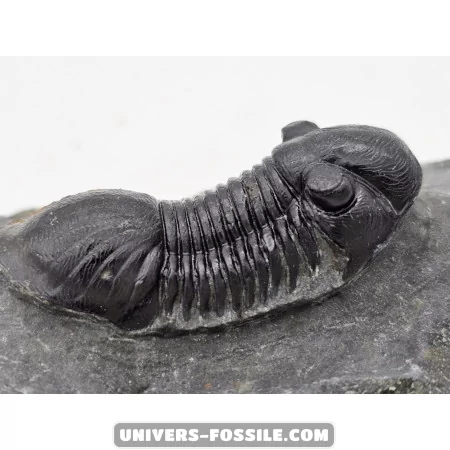Paralejurus spatuliformis: A Fascinating Trilobite from the Middle Ordovician Period

Paralejurus spatuliformis: An Amazing Trilobite
Paralejurus spatuliformis is a species of trilobite that lived during the Middle Ordovician period, approximately 470 million years ago. This fascinating trilobite has been discovered in marine deposits from various parts of the world, including Europe and North Africa.
Paralejurus spatuliformis is characterized by its elongated, flattened body, with a distinct head bearing large compound eyes and sensory antennae. Its exoskeleton was composed of distinct segments, providing it with some flexibility to move along the seafloor.
Habitat
Fossils of Paralejurus spatuliformis have been found in shallow marine environments, indicating that this species preferred coastal waters. They likely inhabited the seafloor, feeding on organic debris and small organisms.
Lifestyle
Like most trilobites, Paralejurus spatuliformis was likely a benthic predator, moving slowly along the seafloor in search of prey. Its robust exoskeleton provided some protection against predators and harsh environmental conditions.
Scientific Significance
Paralejurus spatuliformis is important to paleontologists as it provides valuable insights into the evolution and diversity of trilobites during the Middle Ordovician period.
Paralejurus spatuliformis
The Paralejurus spatuliformis is a remarkable trilobite species that inhabited the ancient seas during the Middle Ordovician period. This fascinating creature offers valuable insights into the biodiversity and evolution of marine organisms during this critical era in Earth's history.
Studying the fossils of Paralejurus spatuliformis provides researchers with a unique opportunity to explore the ancient marine ecosystems and the intricate interactions between different species that existed millions of years ago. The well-preserved exoskeleton and distinctive anatomical features of this trilobite make it a significant subject of study for paleontologists and scientists worldwide.
Exploring Ancient Marine Ecosystems
During the Middle Ordovician period, the oceans teemed with diverse marine life forms, including trilobites like Paralejurus spatuliformis. By analyzing the fossils of this ancient creature, scientists gain valuable insights into the ecology and dynamics of these past marine environments. The study of Paralejurus spatuliformis contributes to our understanding of the interconnectedness of species and the complex food webs that sustained life in the ancient seas.
Unraveling Evolutionary Processes
Through careful examination of Paralejurus spatuliformis fossils, researchers can trace the evolutionary history of this trilobite species and gain a deeper understanding of the evolutionary processes that have shaped life on Earth over millions of years. The study of ancient organisms like Paralejurus spatuliformis provides crucial evidence of how life forms have adapted and diversified over time, offering valuable perspectives on the origins of biodiversity on our planet.
Conclusion: A Window into Earth's Past
In conclusion, Paralejurus spatuliformis stands as a testament to the richness of marine life during the Middle Ordovician period. Its exceptional preservation and unique anatomical features make it a compelling subject for scientific inquiry and exploration. By delving into the fossil record of Paralejurus spatuliformis, researchers unlock crucial insights into the history of life on Earth and the evolutionary forces that have shaped our planet's biological diversity over geological time scales.
